2022 MECUMS MOTORCYCLE AUCTION: FULFILL YOUR MOTORCYCLE DREAMS … HERE & NOW
By Mark Donaldson
The 15 Freeway, known in many other parts of the country as Interstate 15, runs from San Diego to the Canadian border. Heading north out of San Diego this freeway passes many of the most iconic motocross tracks and off road riding areas in the United States. Barona Oaks, Perris, Fox Raceway, Lake Elsinore and Glen Helen; plus, Carlsbad and Saddleback Park were located not far from the 15. As you arrive in the high desert, you pass by Competitive Edge and Racetown 395 as well as many miles of off-road riding. But we are headed up the 15 Freeway because it provides the quickest route to Las Vegas from Southern California. We are headed to the yearly Mecum Motorcycle Auction, which is returning this year to the South Point Arena in Las Vegas after a one-year stint at the Las Vegas Convention Center . The Mecum auction is back on its normal schedule of being held in January, with, of course, all of the current covid protocols.
 You don’t see a lot of Swedish-built Flink MX250s. This one was bid up to $7500, but the seller didn’t agree.
You don’t see a lot of Swedish-built Flink MX250s. This one was bid up to $7500, but the seller didn’t agree.
This year the auction ran from Tuesday through Saturday, but there are fewer motorcycles crossing the auction block over the five days and the length of the auction was several hours shorter each day compared to pre-covid auctions. Many of the motorcycles this year were coming out of both known and little known collections with the owners rotating or scaling down their collections. There were also some lower-quality motorcycles that would have never made the auction list a few years ago. Generally, the best of the motorcycles cross the auction stage on Friday and Saturday, but that is not always the case as there are many very nice motorcycles auctioned earlier in the week. Once again this year we saw more motocross and other racing series motorcycles being showcased across the stage with many of the race bikes recording record sale prices and below are the ones that we traversed the 15 Freeway to focus on.
 Based on the bike that Harry Everts raced to the 1975 FIM 250 World Championship, the 1976 Puch MC250 had two carburetors—one piston port and the other rotary valve.
Based on the bike that Harry Everts raced to the 1975 FIM 250 World Championship, the 1976 Puch MC250 had two carburetors—one piston port and the other rotary valve.
 If you owned one of the 97 Puch MC250s that were built in 1976, you might have been as lucky as this owner who got $55,000 at Mecums.
If you owned one of the 97 Puch MC250s that were built in 1976, you might have been as lucky as this owner who got $55,000 at Mecums.
Why does MXA choose to make the trek to Las Vegas and the motorcycle auction each year? First and foremost, it is to see friends, both old and the new, that we acquired while at auctions in the past, along with mingling with a large group of people who share a common passion from all over the world. It’s a place to gather and toast friends we have lost, some of whom influenced our lives. Then there are the motorcycles themselves, hundreds of them in one place. Every year you will find makes or models of motorcycles that you have never heard of or seen before, along with the more commonly known brands and models. The knowledge base at the auction is vast. All you need to do is ask someone to share their knowledge about a particular motorcycle and they are extremely accommodating. It is a place where you can inspect and purchase the motorcycle of your dreams — right here, right now.
 Designed by Sten Lundin, tested by Torsten Hallman, raced by Bengt Aberg and sold in America as a kit bike by Lars Larsson, this 1979 Yamaha HL 540 was hammered out at $27,500.
Designed by Sten Lundin, tested by Torsten Hallman, raced by Bengt Aberg and sold in America as a kit bike by Lars Larsson, this 1979 Yamaha HL 540 was hammered out at $27,500.
 Although the HL500 was sold in Europe as a complete bike with a TT500 engine, wheels and parts, this HL500 features a 540cc four-stroke engine.
Although the HL500 was sold in Europe as a complete bike with a TT500 engine, wheels and parts, this HL500 features a 540cc four-stroke engine.
For those who have never attended a major vehicle auction, the strategically placed lights on the stage can make almost any motorcycle look amazing. From a camera view high above the stage or at a wide angles, the nicks, dents and scratches do not show. Most bikes are given a wipe down before being pushed up onto stage so they look their best. In the Mecum Auctions General Rules, it is stated that all lots are sold “as is, where is.” A bidder can be in attendance at the auction or place a bid both online or on the telephone, once they have completed the bidder registration. It is up to all bidders to do their homework before bidding on a motorcycle. At times motorcycles can be misrepresented by the seller, both knowingly and unknowingly. If you are not able to attend the auction in person try to have someone you know or a marque specialist that is in attendance at the auction look the motorcycle over for you. If you see a motorcycle that has sold for what seems to be a bargain price there is usually a good reason it was a bargain. The same goes for motorcycles that see record sale prices.
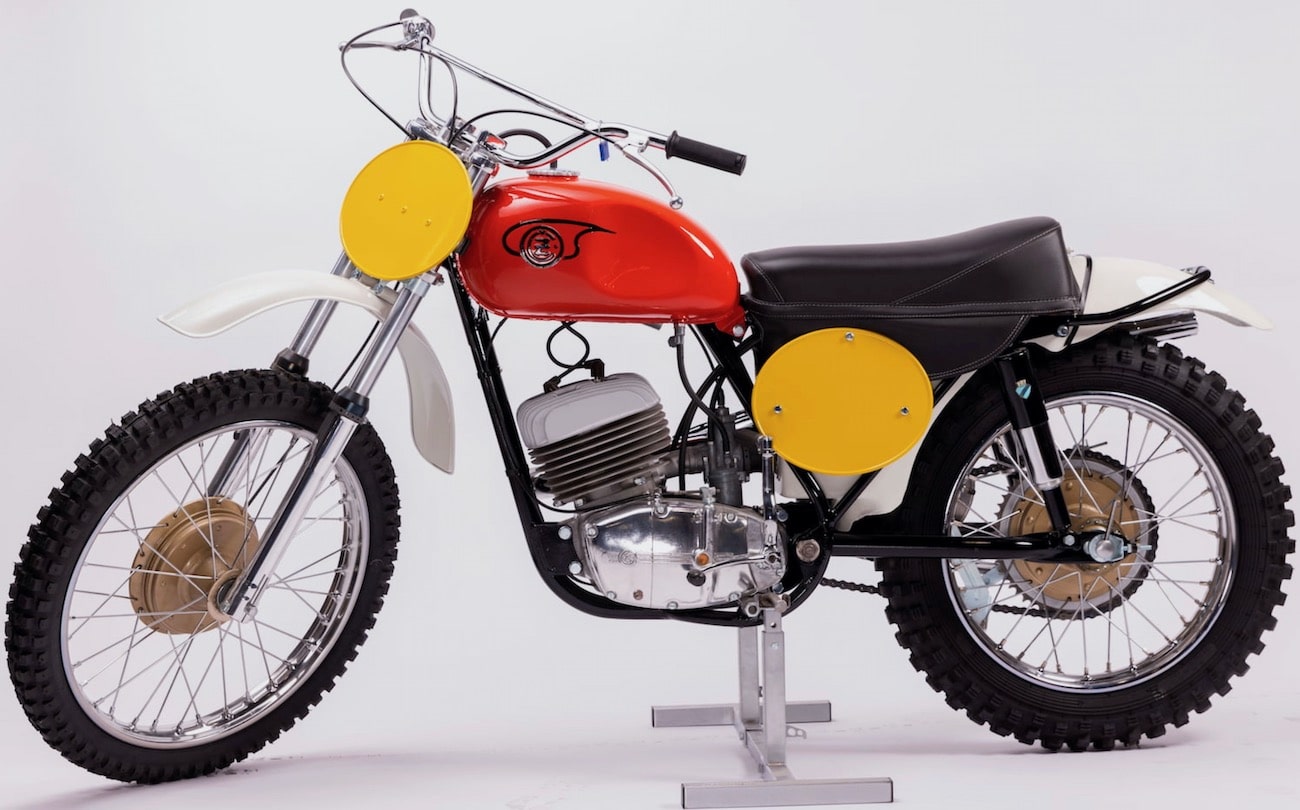 The workhorse of vintage racing, Czech-made CZs can be gussied up to fetch a fair penny at a motorcycle auction. This 1969 CZ 360 Side-Pipe sold for $16,500.
The workhorse of vintage racing, Czech-made CZs can be gussied up to fetch a fair penny at a motorcycle auction. This 1969 CZ 360 Side-Pipe sold for $16,500.
 The closer a classic motorcycle gets to looking like it just rolled down the assembly line, the more money it is worth. This CZ is a little too shiny for our tastes.
The closer a classic motorcycle gets to looking like it just rolled down the assembly line, the more money it is worth. This CZ is a little too shiny for our tastes.
TO BECOME AN AUCTION BIDDER
To become a bidder at the auction there is a $200 bidder’s fee. The sale price that we have listed is only the hammer price (sold price)—plus a buyers fee. That fee is either 10% (if you are in attendance) or 12% (if you are an online or telephone bidder ). There is a $500.00 minimum fee per vehicle. Motorcycles can be paid for by check (with certified funds) or wire transfer ($100 fee). Credit cards (3.5% of the transaction amount) can only be used on road art.
It is exciting to be the proud new owner of a motorcycle that has crossed the auction block, but there are other fees that must be paid before your motorcycle can leave the auction site. If a motorcycle is sold on a Bill of Sale then you must pay Nevada Vehicle sales tax (8.25%) — unless you have a dealer’s license. If the motorcycle is sold with a title, then you pay the sales tax in your state or country when you title the motorcycle in your name. There is an $80.00 document fee that must also be paid to the auction company. Once all of this is completed, you have 48 hours to remove the motorcycle from the auction location. There are shipping companies on site that will ship your bike purchase, both nationally and internationally. National shipping ranges from $125 to $800 from Las Vegas.
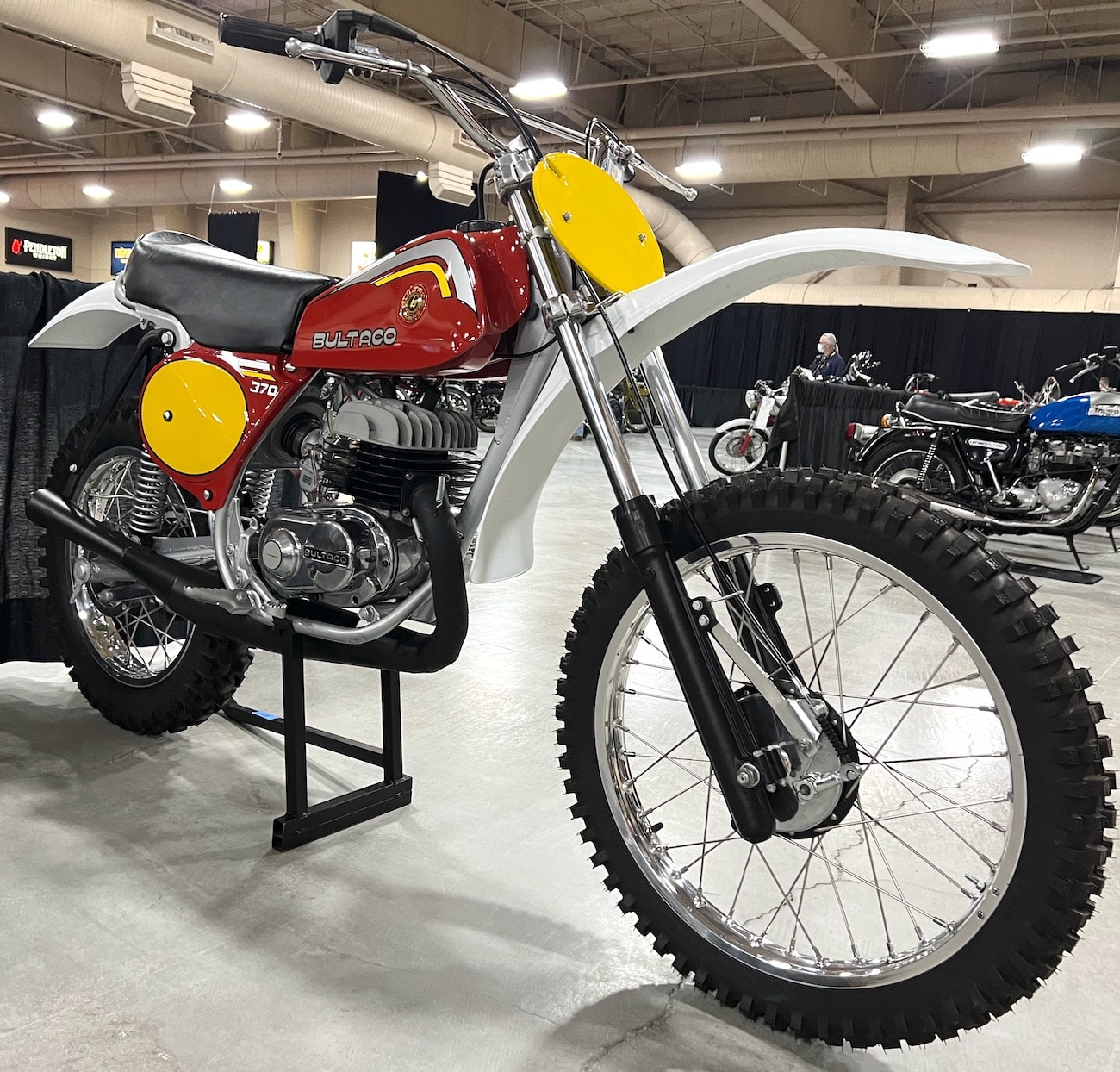 On the other hand, Bultacos came down the assembly line as shiny as possible. The 1977 Bultaco 370 Pursang brought in $16,500.
On the other hand, Bultacos came down the assembly line as shiny as possible. The 1977 Bultaco 370 Pursang brought in $16,500.
When our five days in Las Vegas came to an end, we hit the 15 Freeway and headed back to SoCal, and passed the 270 miles talking about the bikes, the crazy prices, the sweet deals and the people we met. Yes, we did have those moments as we crossed the desert where we said, “I had one of those once. I never should have sold it, but if I kept every bike I ever had, I would need to buy an abandoned Walmart store to keep them in.”
 It wouldn’t be a proper motorcycle auction without the race bike of a famous rider going up for sale. This 1980 KTM 250 was raced in the 250 World Championships by Broc Glover. Broc’s bike was rebuilt many times during the 1980 season, but luckily KTM had a small stockpile of left-over parts to keep this one running. It sold for $11,000, but Broc never owned it so he didn’t reap any reward.
It wouldn’t be a proper motorcycle auction without the race bike of a famous rider going up for sale. This 1980 KTM 250 was raced in the 250 World Championships by Broc Glover. Broc’s bike was rebuilt many times during the 1980 season, but luckily KTM had a small stockpile of left-over parts to keep this one running. It sold for $11,000, but Broc never owned it so he didn’t reap any reward.
 You don’t think of Ducati when it comes to motocross bikes, but this 1965 Ducati 250 Scrambler proves that they had the chops for it. At $6600, the Duck can only grow in value.
You don’t think of Ducati when it comes to motocross bikes, but this 1965 Ducati 250 Scrambler proves that they had the chops for it. At $6600, the Duck can only grow in value.
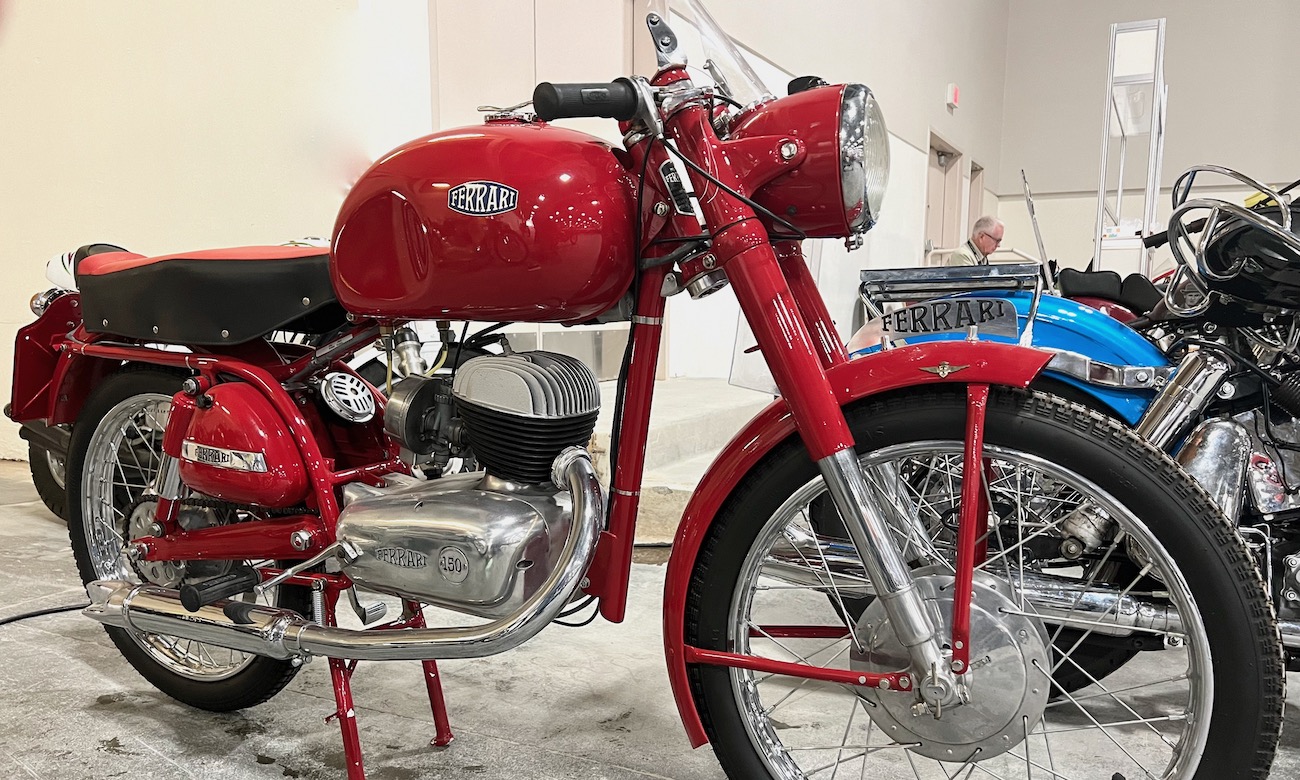 Although Enzo Ferrari founded the Scuderia Ferrari racing team in 1929 (for motorcycles and automobiles), he was not involved in Ferrari Motorcycles. Instead, the Ferrari brothers from Milan starting making Fratelli Ferrari 150cc two-stroke bikes in 1951—using skills that one brother had learned at the Parilla factory.
Although Enzo Ferrari founded the Scuderia Ferrari racing team in 1929 (for motorcycles and automobiles), he was not involved in Ferrari Motorcycles. Instead, the Ferrari brothers from Milan starting making Fratelli Ferrari 150cc two-stroke bikes in 1951—using skills that one brother had learned at the Parilla factory.
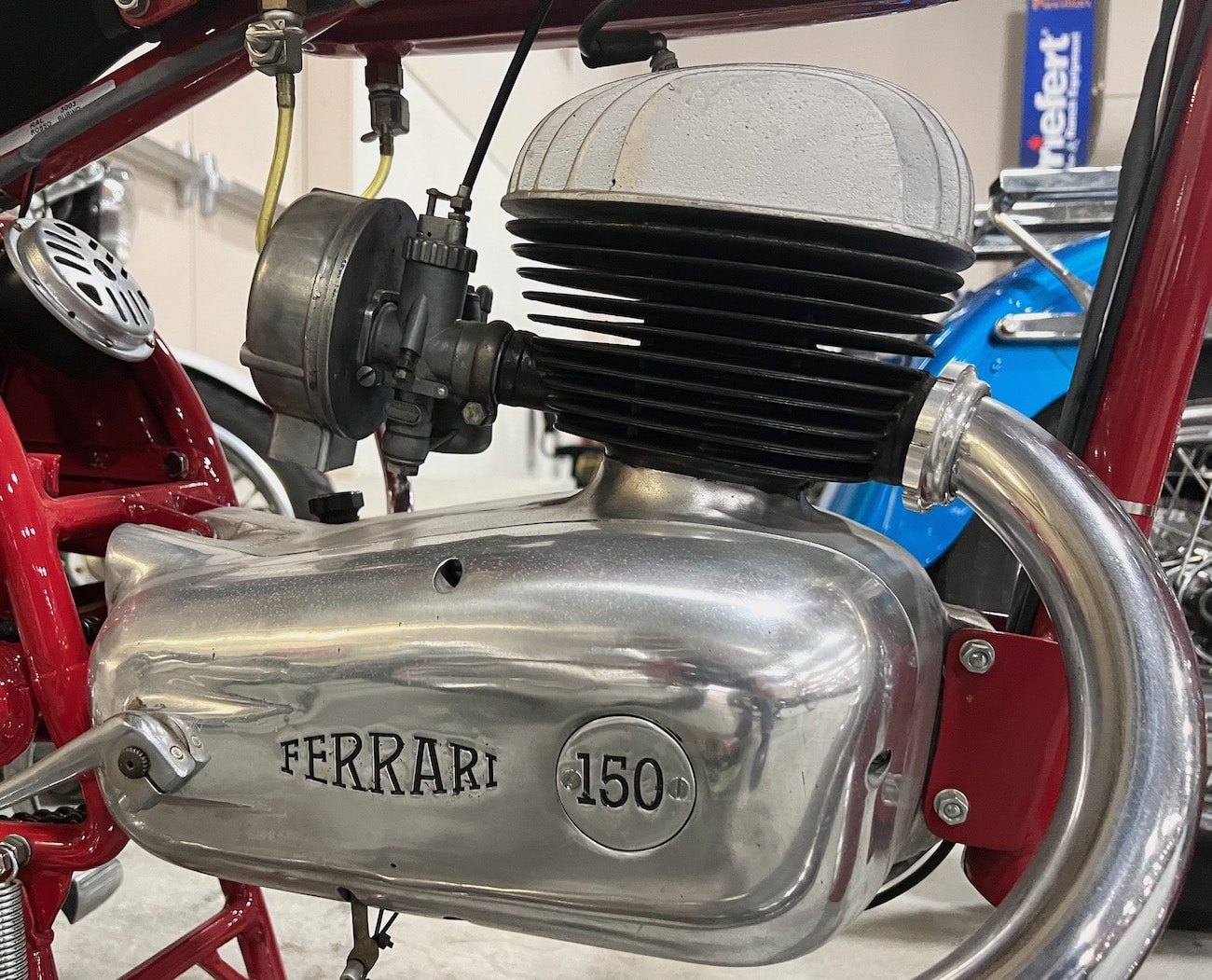 Fratelli Ferrari (Ferrari Brothers) only last three years, they made 125cc, 150cc and 165cc singles and a very rare 250 twin. Sadly, in 1954 Enzo Ferrari’s lawyers shut them down for brand infringement. This rare Ferrari was as Mecums, but it never crossed the block.
Fratelli Ferrari (Ferrari Brothers) only last three years, they made 125cc, 150cc and 165cc singles and a very rare 250 twin. Sadly, in 1954 Enzo Ferrari’s lawyers shut them down for brand infringement. This rare Ferrari was as Mecums, but it never crossed the block.
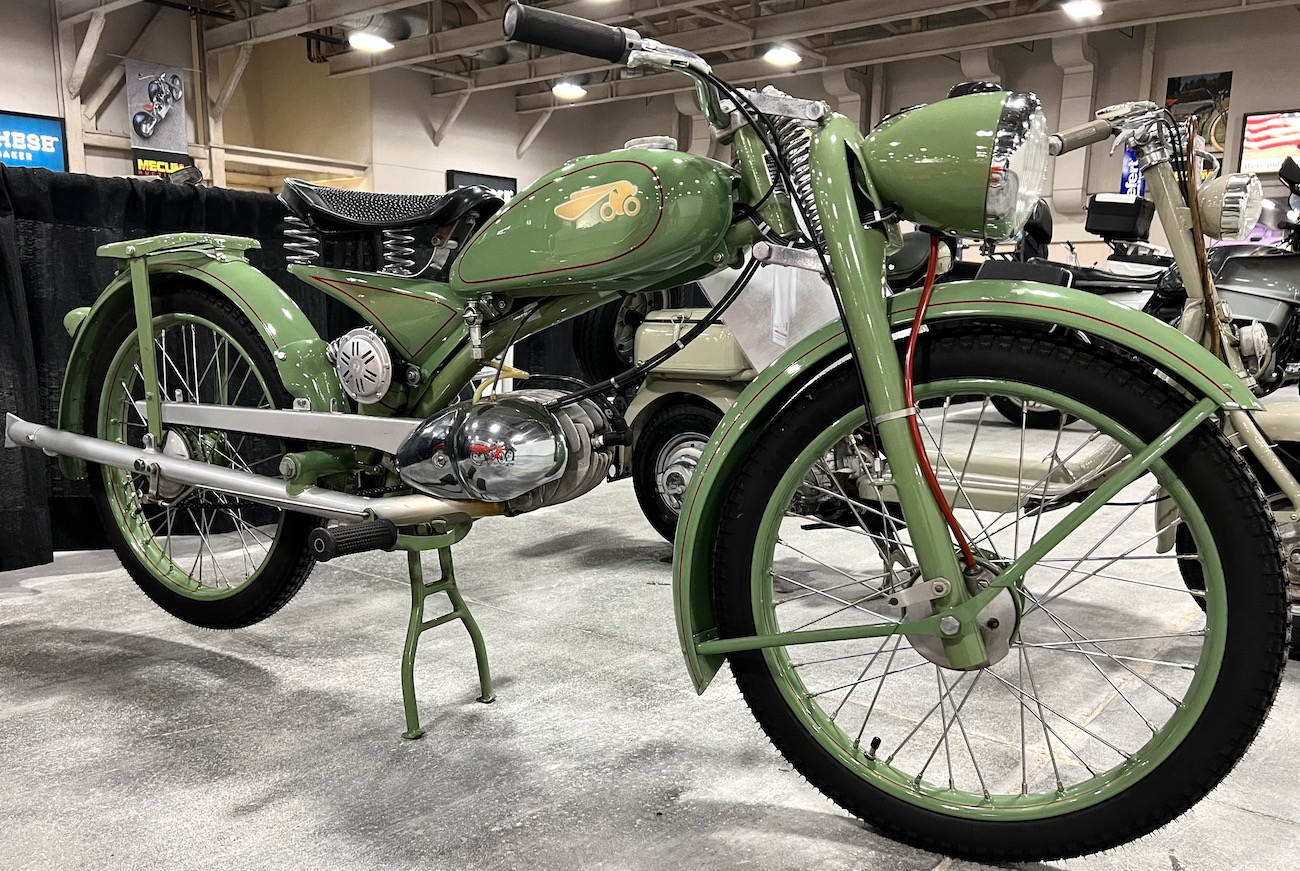 The 1951 Riedel-Imme R100 is one of the most unique bikes made in the post-WWII era. All the tubes are the same diameters (forks, frame, swingarm). The engine goes up and down with the rear wheel. The swingarm is also the exhaust pipe. The engine looks like it has a rotary valve, but it is a piston port design and the cylinder and head are one-piece. The forks only have one fork leg and the rear suspension is a mono-spring design. It sold for $24,200.
The 1951 Riedel-Imme R100 is one of the most unique bikes made in the post-WWII era. All the tubes are the same diameters (forks, frame, swingarm). The engine goes up and down with the rear wheel. The swingarm is also the exhaust pipe. The engine looks like it has a rotary valve, but it is a piston port design and the cylinder and head are one-piece. The forks only have one fork leg and the rear suspension is a mono-spring design. It sold for $24,200.
 The 1976 Can-Am 250MX was powered a rotary valve engine, that had the carburetor mounted at the end of a 32mm tube that fed fuel from the carb down to the crank-mounted rotary valve. It was a very good packaging that allowed for a large airbox that breathed through vents in the seat. This model came out one year before the infamous 1977 Black Widow. It sold for $6050.
The 1976 Can-Am 250MX was powered a rotary valve engine, that had the carburetor mounted at the end of a 32mm tube that fed fuel from the carb down to the crank-mounted rotary valve. It was a very good packaging that allowed for a large airbox that breathed through vents in the seat. This model came out one year before the infamous 1977 Black Widow. It sold for $6050.
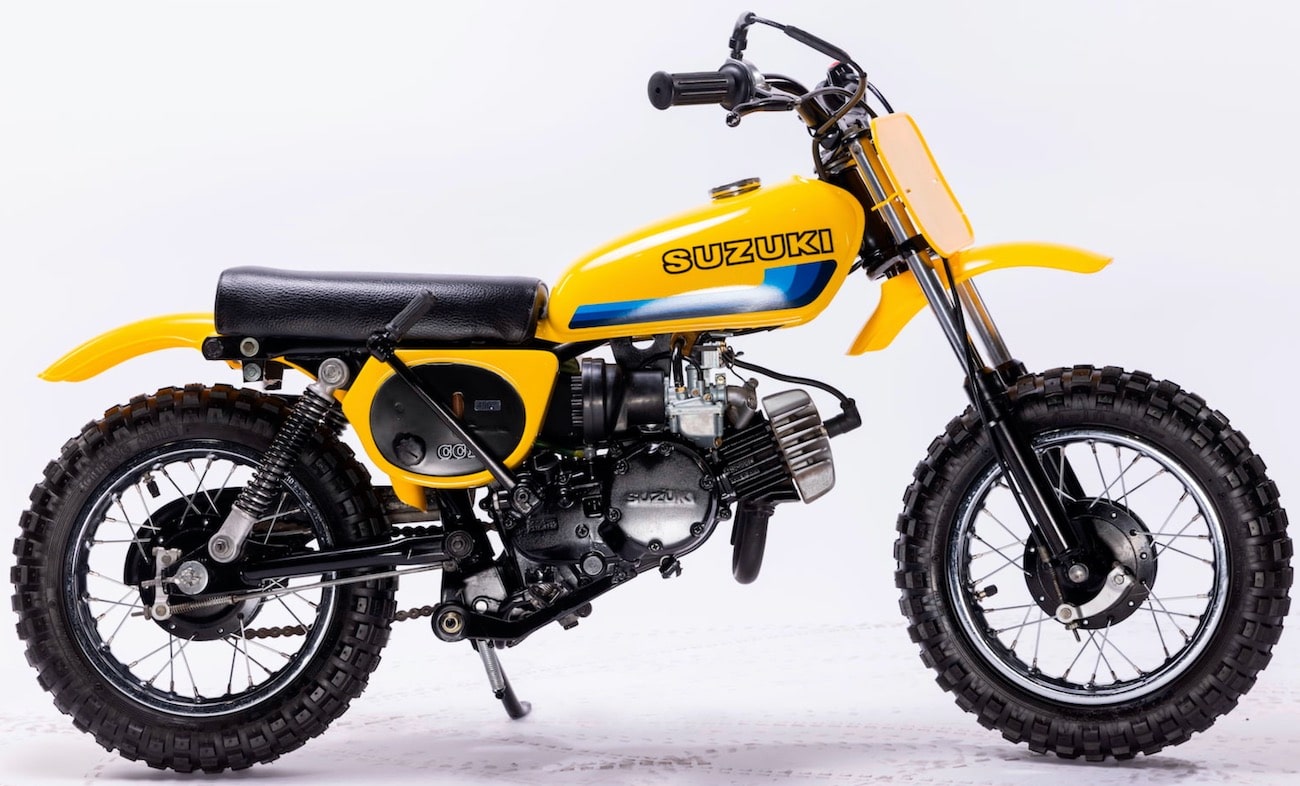 Suzuki’s 50cc kids bike was the JR50. It was produced from 1977 to 2006 and taught many kids how to ride. It is best known for its “Power Reduction Plate,” which was a large washer with a small hole in it to make the bike easier to ride until the kid developed some skills. This 1980 model’s high bid was $3850.
Suzuki’s 50cc kids bike was the JR50. It was produced from 1977 to 2006 and taught many kids how to ride. It is best known for its “Power Reduction Plate,” which was a large washer with a small hole in it to make the bike easier to ride until the kid developed some skills. This 1980 model’s high bid was $3850.
 The 1963 Triumph TS20 Tiger Cub was a beautiful machine. With its 199cc displacement, 63mm by 64mm bore-and-stroke, large 27mm Amal Monobloc and four-speed transmission, the base TS20 was a success for Triumph—they sold 60,000 units. As for the Tiger Cub racing version, only 340 TS20s were produced in 1963, with 97 percent of them shipped to the U.S. Its price represents its position in British dirt bike racing. It sold for $14,300.
The 1963 Triumph TS20 Tiger Cub was a beautiful machine. With its 199cc displacement, 63mm by 64mm bore-and-stroke, large 27mm Amal Monobloc and four-speed transmission, the base TS20 was a success for Triumph—they sold 60,000 units. As for the Tiger Cub racing version, only 340 TS20s were produced in 1963, with 97 percent of them shipped to the U.S. Its price represents its position in British dirt bike racing. It sold for $14,300.
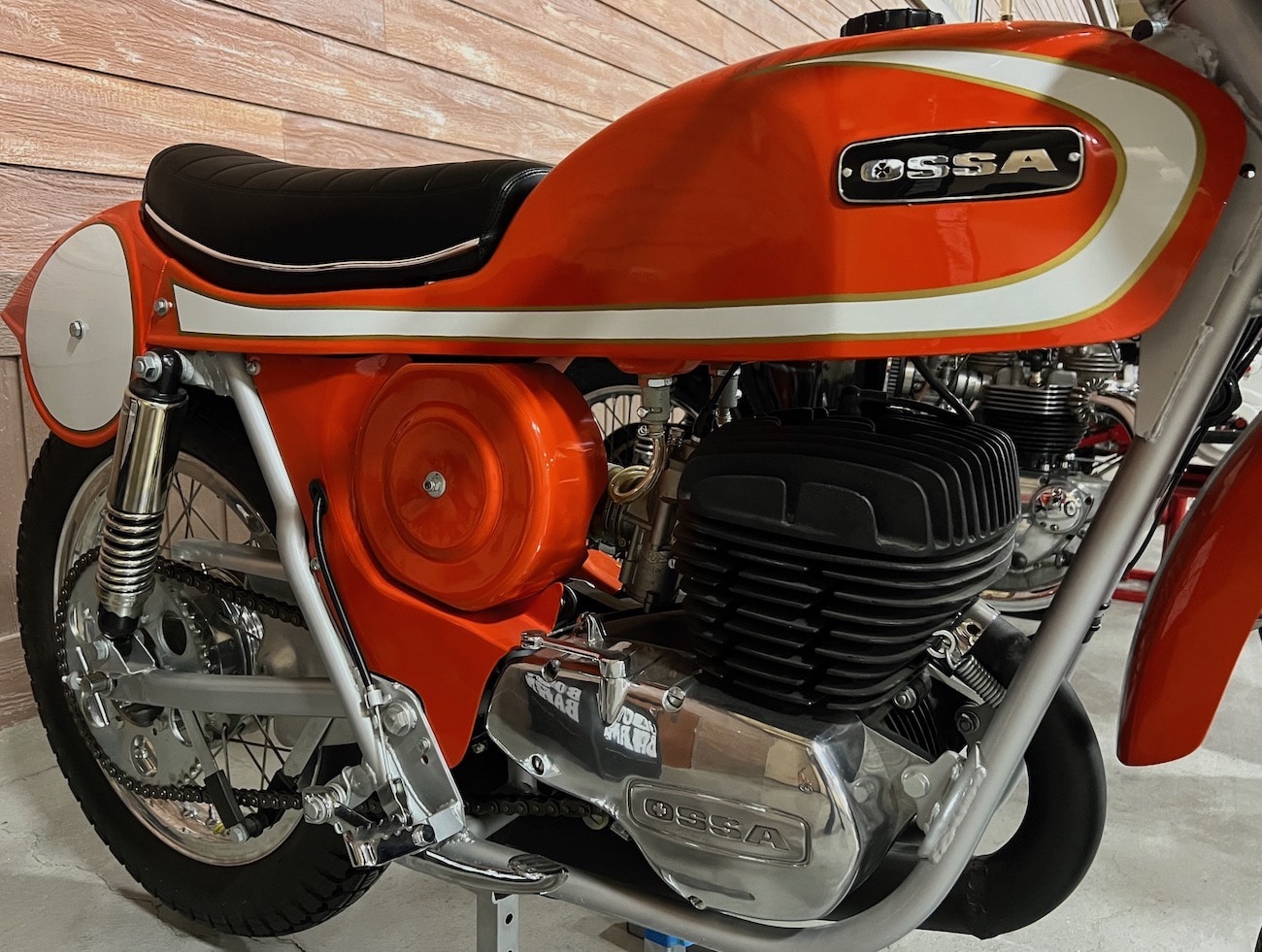 The 1970 Ossa Stiletto 250 was a work of art with its creative fiberglass bodywork, tucked in airbox and sculpted front and rear fenders. If you crash a Stiletto you littered the tracks with shards of fiberglass. $13,200 took it home.
The 1970 Ossa Stiletto 250 was a work of art with its creative fiberglass bodywork, tucked in airbox and sculpted front and rear fenders. If you crash a Stiletto you littered the tracks with shards of fiberglass. $13,200 took it home.
 This 1973 Montesa 250 VR (Vehkonen Replica) sold for $14,300.
This 1973 Montesa 250 VR (Vehkonen Replica) sold for $14,300.
 The 1971 Bultaco 250 Matador SD was Bultaco’s International Six Day Trials (ISDT) enduro race bike. It sold for $13,200.
The 1971 Bultaco 250 Matador SD was Bultaco’s International Six Day Trials (ISDT) enduro race bike. It sold for $13,200.
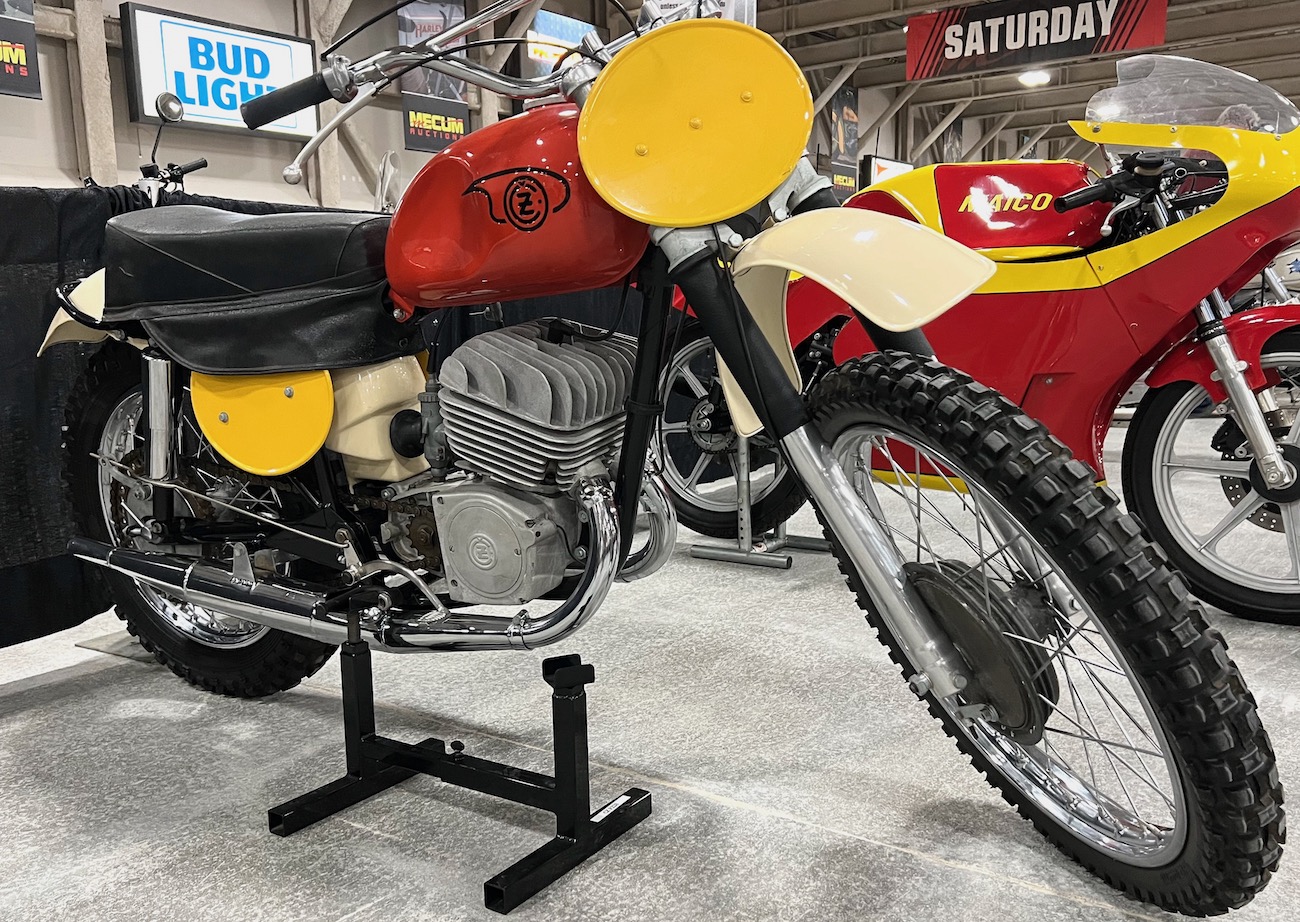 Nothing is as fabled as the 1967 CZ 250 twin-piper. Who would believe that it would take $22,000 to own one in 2022.
Nothing is as fabled as the 1967 CZ 250 twin-piper. Who would believe that it would take $22,000 to own one in 2022.
 With Preston Petty fenders instead of the stock metal fenders and Betor telescopic forks instead of the more interesting leading links, this 1973 DKW 125 Hornet only sold for $3520.
With Preston Petty fenders instead of the stock metal fenders and Betor telescopic forks instead of the more interesting leading links, this 1973 DKW 125 Hornet only sold for $3520.
 1974 Maico 400 GP was the mid-season update to keep local Maico riders on bikes as close as possible to what the factory team used. The 400 GP was the first production bike with moved-up shocks. It sold at Mecums for $11,000
1974 Maico 400 GP was the mid-season update to keep local Maico riders on bikes as close as possible to what the factory team used. The 400 GP was the first production bike with moved-up shocks. It sold at Mecums for $11,000
 Often billed as the greatest all-around motocross bike ever built, The 1981 Maico 490 Mega2 had a broad, torquey and fast powerband mated to a razor sharp chassis and German engineering. This 490 sold for $10,000.
Often billed as the greatest all-around motocross bike ever built, The 1981 Maico 490 Mega2 had a broad, torquey and fast powerband mated to a razor sharp chassis and German engineering. This 490 sold for $10,000.
 This 1969 Indian MM5 Mini Bambino was produced in Italy by Italjet. The imported two-stroke machine mustered 1.5 horsepower from its MotoMorini Franco S5K 50cc engine. At the Mecum Auction this MM5 sported a custom flame paint and chrome job. It sold for the ridiculous price of $10,450.
This 1969 Indian MM5 Mini Bambino was produced in Italy by Italjet. The imported two-stroke machine mustered 1.5 horsepower from its MotoMorini Franco S5K 50cc engine. At the Mecum Auction this MM5 sported a custom flame paint and chrome job. It sold for the ridiculous price of $10,450.
 Sporting Johnny O’Mara “N1” number from his first year on Hiro Honda’s Mugen team, this Mugen ME125 sold for $18,700 at Mecums.
Sporting Johnny O’Mara “N1” number from his first year on Hiro Honda’s Mugen team, this Mugen ME125 sold for $18,700 at Mecums.
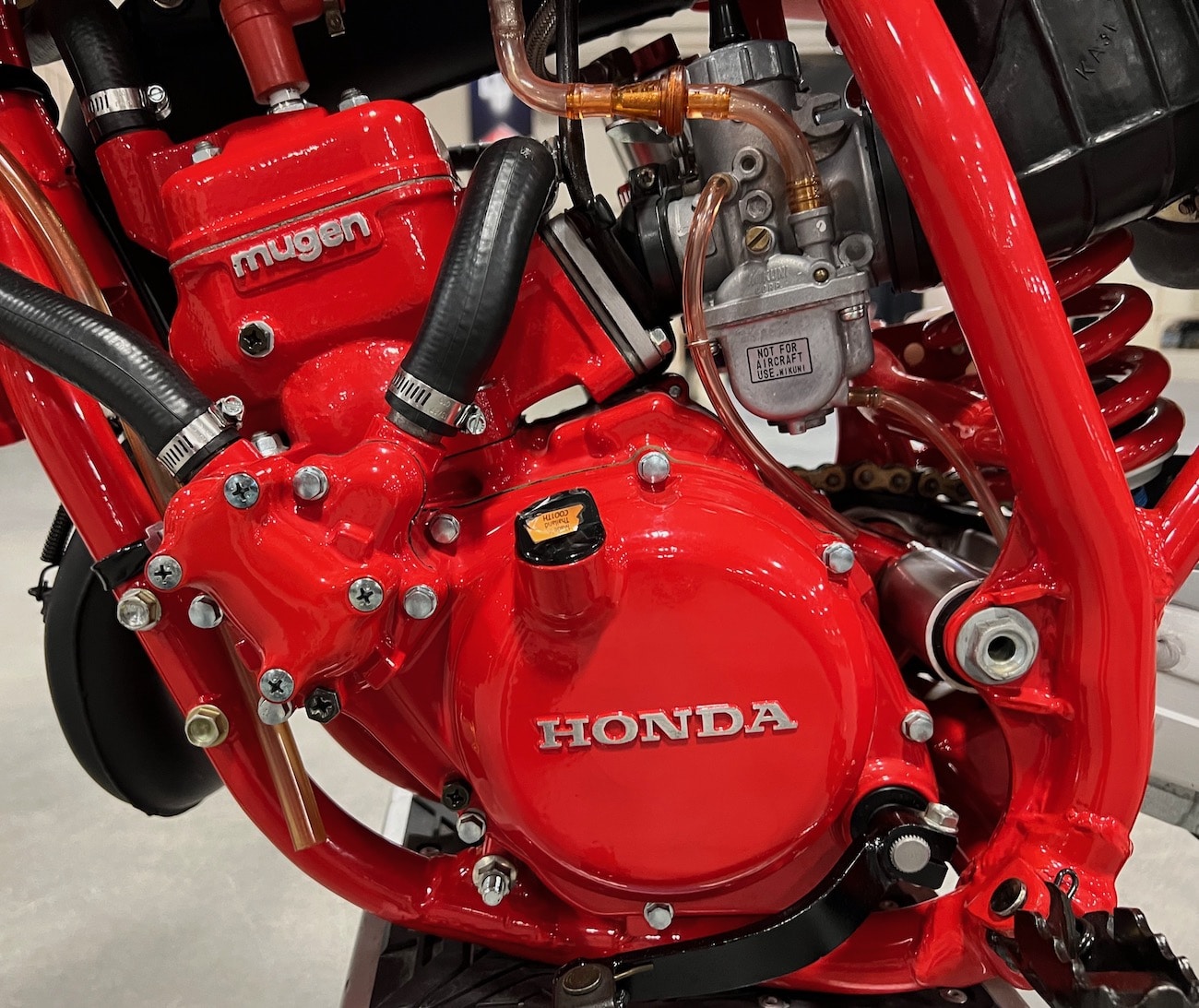 Back in 1980 you could buy a complete Mugen ME125 for $4000. At Mecum you only had to pay four times as much.
Back in 1980 you could buy a complete Mugen ME125 for $4000. At Mecum you only had to pay four times as much.
 This 1980 Honda features a Works Mugen ME360 engine kit with works transmission gear and race crank. The suspension is works as well (along with the alloy gas tank). The frame, engine cases and hubs have been powder-coated. All that trickness came at a price— $19,800.
This 1980 Honda features a Works Mugen ME360 engine kit with works transmission gear and race crank. The suspension is works as well (along with the alloy gas tank). The frame, engine cases and hubs have been powder-coated. All that trickness came at a price— $19,800.
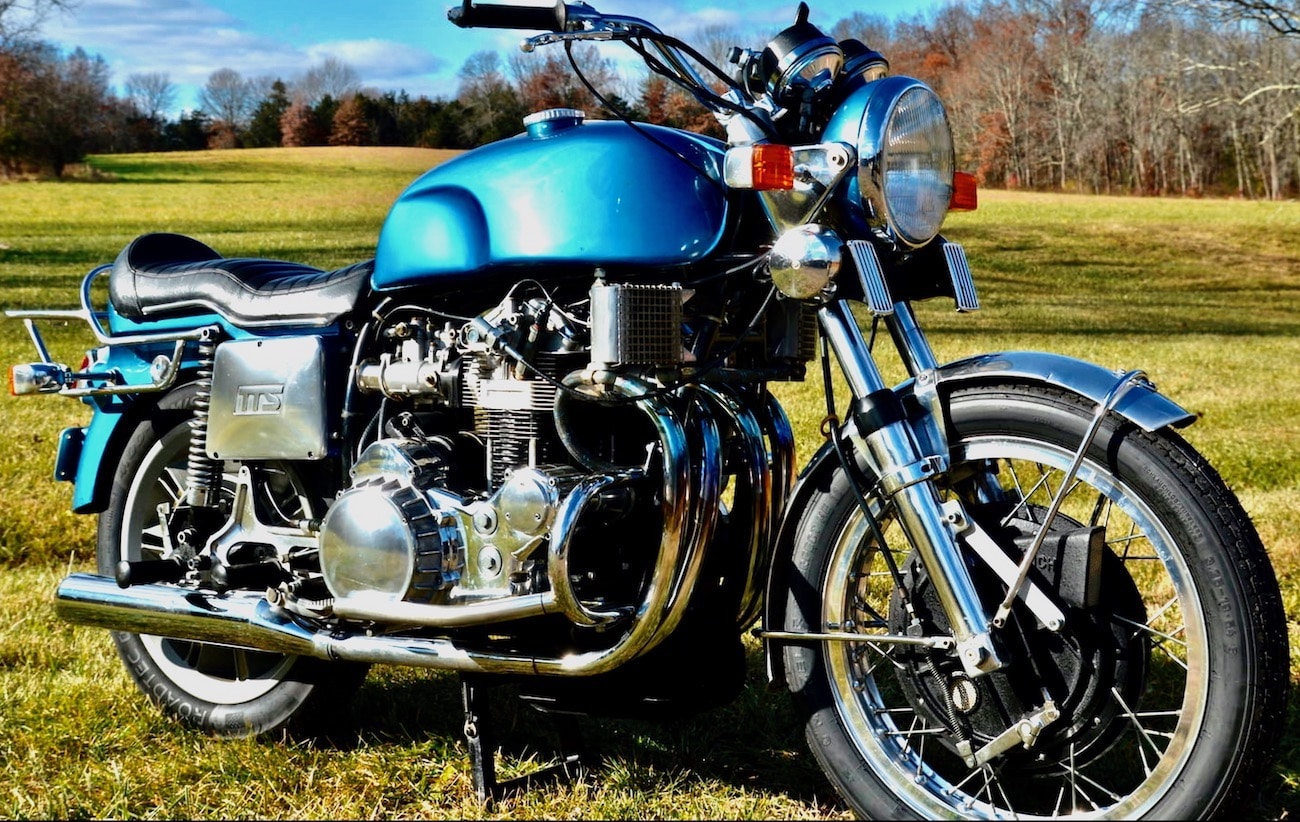 The Munch Mammoth was first shown to the public in 1966. It combined an air-cooled, high-performance, inline four-cylinder, 996cc, NSU Prinz automobile engine in a modern, double-loop frame. The chain ran in an oil bath.
The Munch Mammoth was first shown to the public in 1966. It combined an air-cooled, high-performance, inline four-cylinder, 996cc, NSU Prinz automobile engine in a modern, double-loop frame. The chain ran in an oil bath.
 The base price of a Munch Mammoth TTS in 1973 was $5135. Fewer than 500 Munch machines were built in its 25-year run. This 1973 model crossed the block at $82,500.
The base price of a Munch Mammoth TTS in 1973 was $5135. Fewer than 500 Munch machines were built in its 25-year run. This 1973 model crossed the block at $82,500.
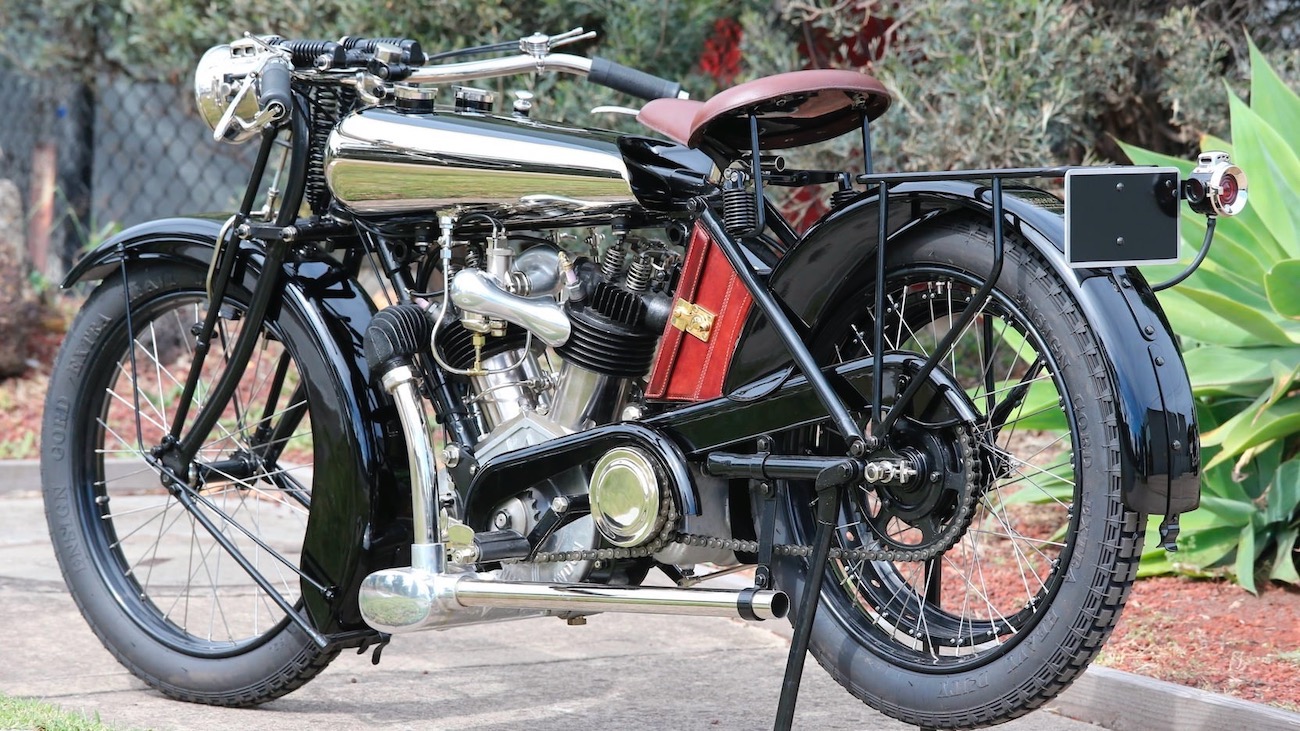 This is a 1922 Brough Superior. The highest bid for it at the 2022 Mecum Motorcycle Auction was $260,000. It was turned down.
This is a 1922 Brough Superior. The highest bid for it at the 2022 Mecum Motorcycle Auction was $260,000. It was turned down.


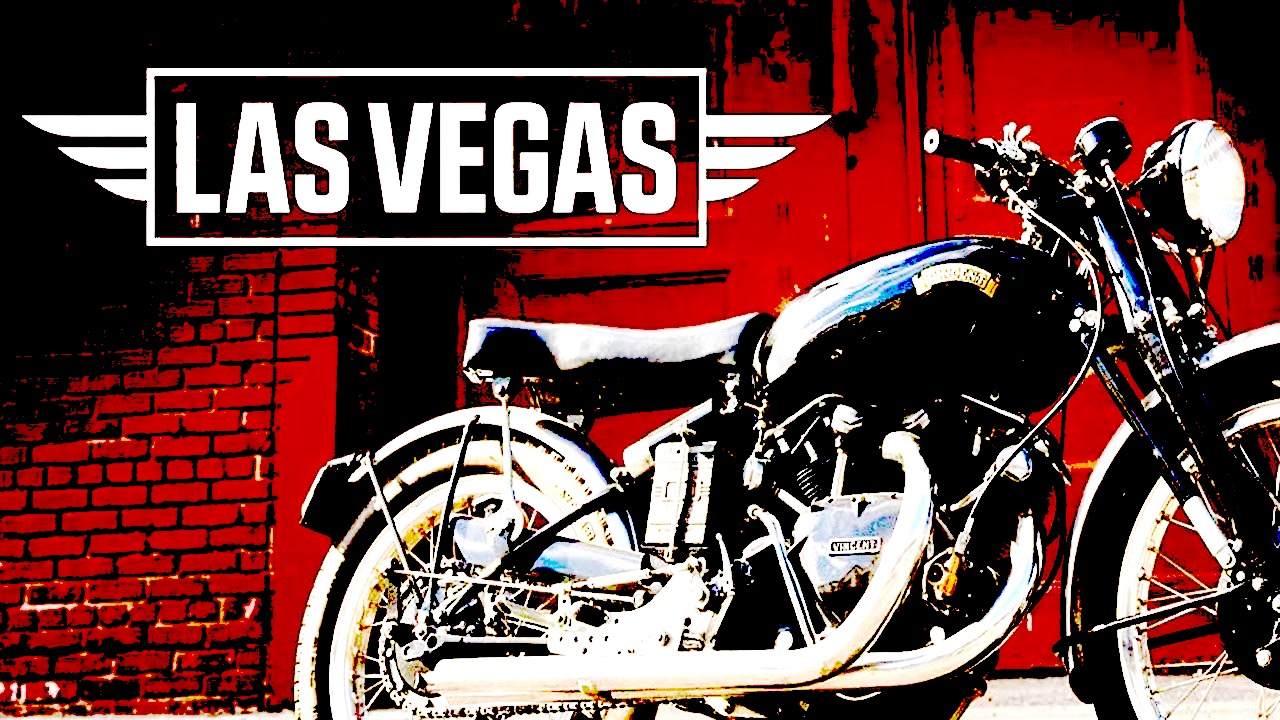
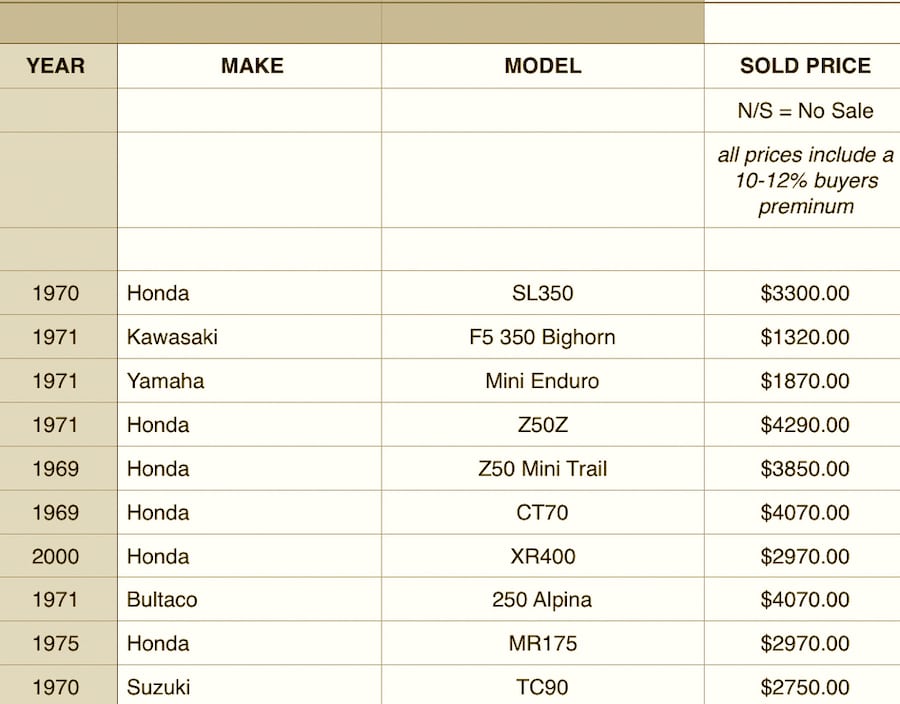
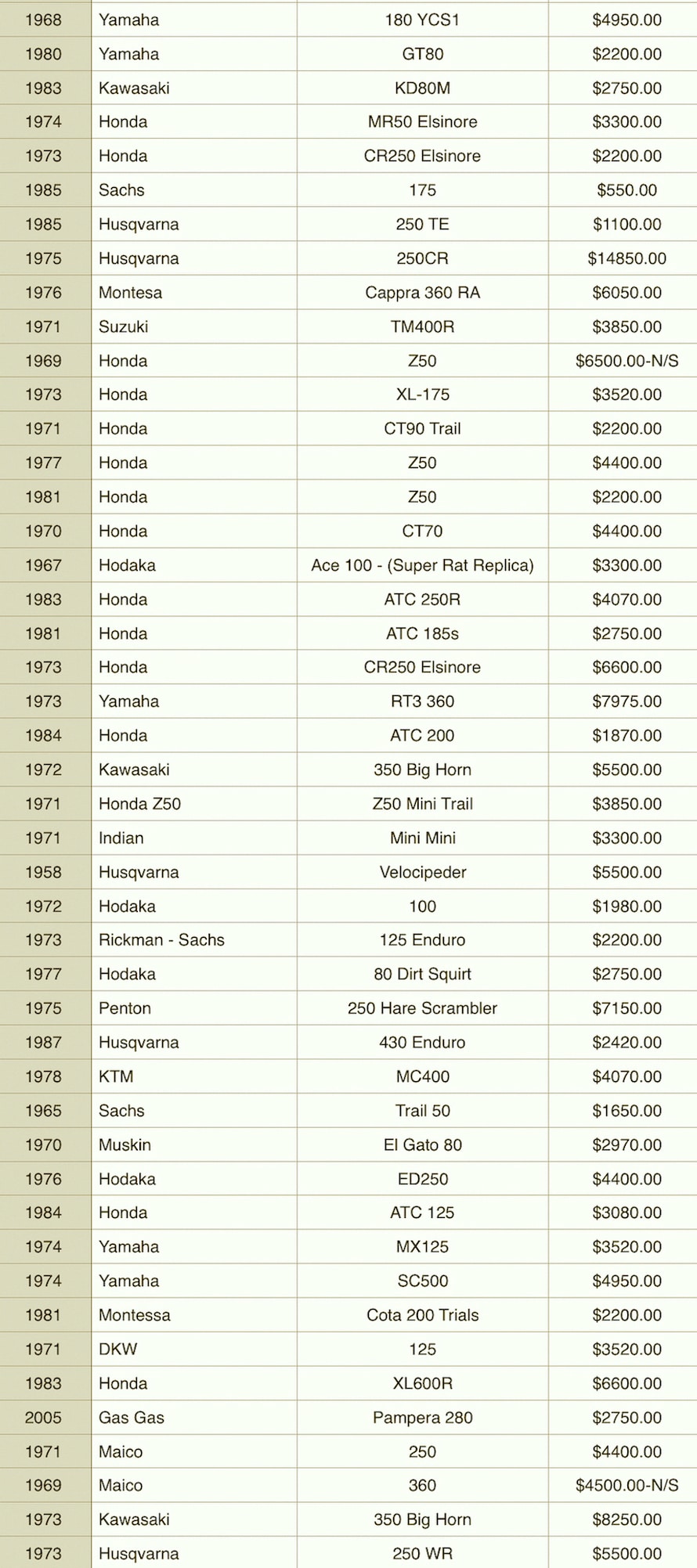





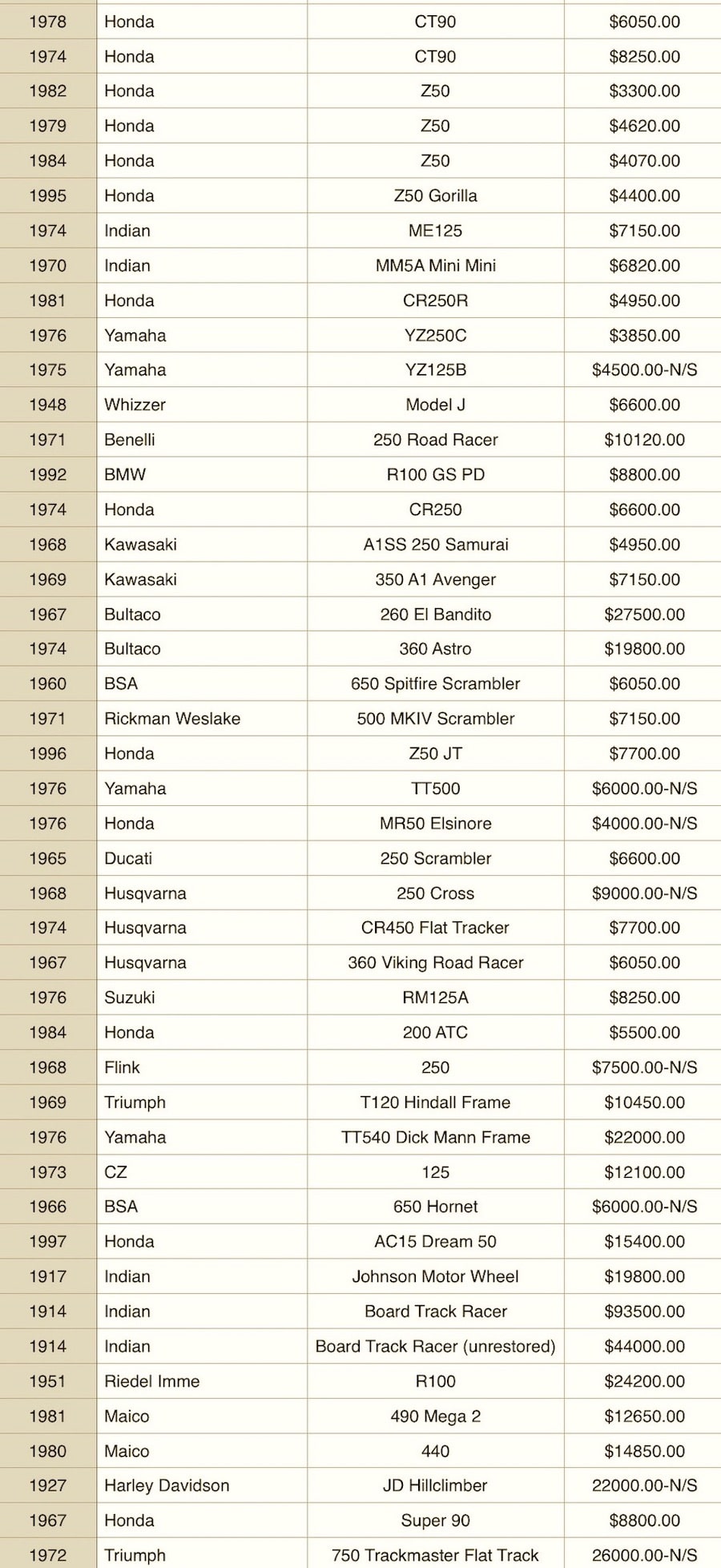
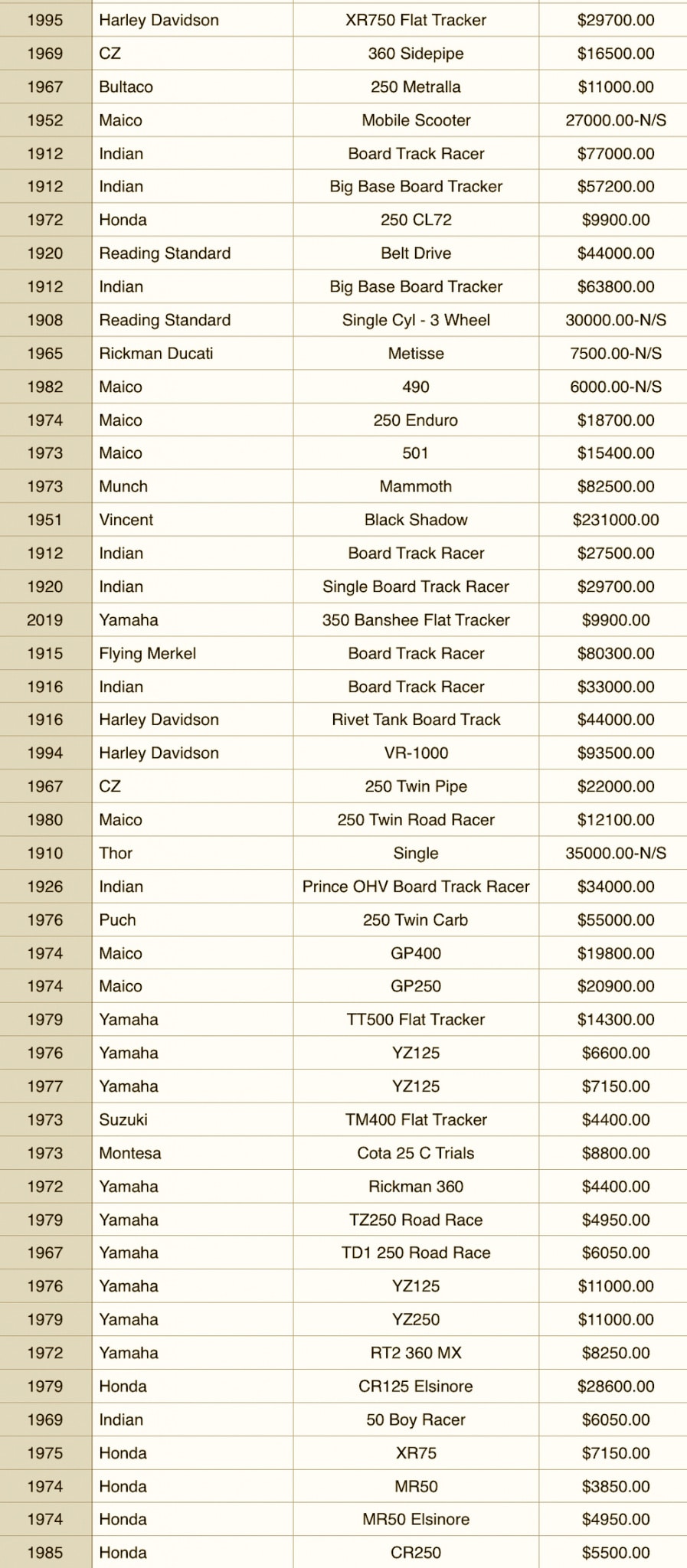
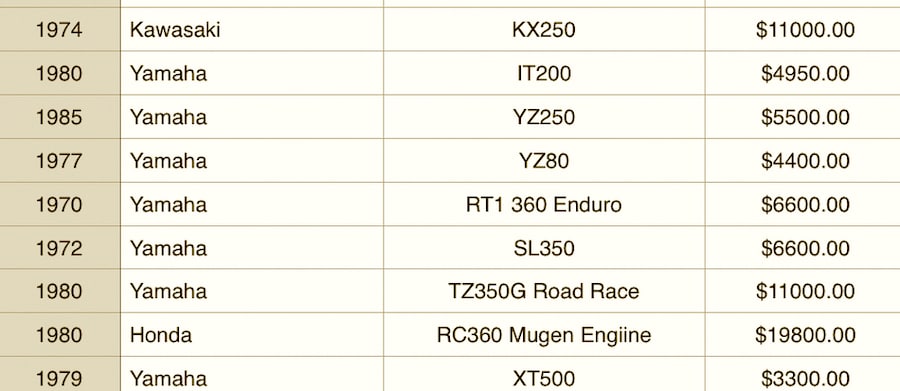
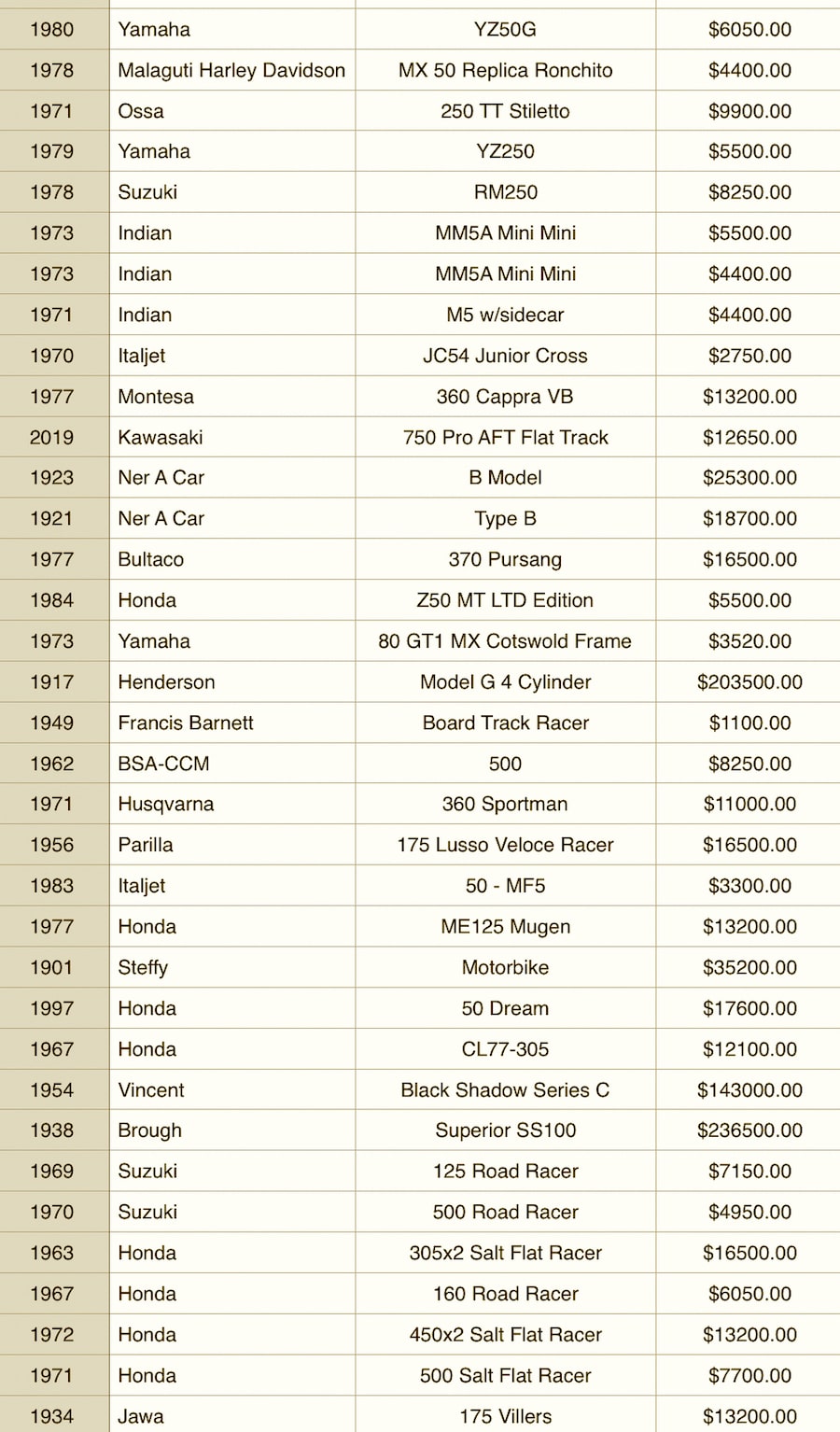



Comments are closed.